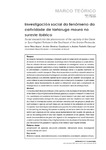Mostrar o rexistro simple do ítem
Investigación social do fenómeno da catividade de tartaruga moura no sureste ibérico
| dc.contributor.author | Pérez Ibarra, Irene | |
| dc.contributor.author | Giménez Casalduero, Andrés | |
| dc.contributor.author | Pedreño Cánovas, Andrés | |
| dc.date.accessioned | 2009-11-10T11:51:28Z | |
| dc.date.available | 2009-11-10T11:51:28Z | |
| dc.date.issued | 2007 | |
| dc.identifier.citation | Ambientalmente sustentable 2007, 4: 35-49 ISSN: 1887-2417 | es_ES |
| dc.identifier.issn | 1887-2417 | |
| dc.identifier.uri | http://hdl.handle.net/2183/5044 | |
| dc.description.abstract | [Resumo] No presente manuscrito investígase a dimensión social da conservación de especies a través do estudo do fenómeno da catividade da tartaruga moura (Testudo graeca) no sueste ibérico. Para iso utilizaron técnicas cuantitativas e cualitativas de investigación social, en concreto, enquisas a poboación autóctona e a novos residentes do turismo internacional e entrevistas en profundidade a colectivos que manteñen tartarugas cativas e a aqueles implicados na conservación e xestión da especie. Estas técnicas permitiron cuantificar a situación actual e as tendencias a coleccionar e posuír tartarugas en catividade, permitiron determinar as motivacións destas prácticas e as diferentes representacións sociais que se manteñen cara á especie, así como coñecer os posicionamentos existentes cara á conservación da especie. A partir destes resultados danse recomendacións de xestión e intervención social para a conservación da tartaruga moura no sueste ibérico e a xestión da poboación cativa de tartaruga moura. | es_ES |
| dc.description.abstract | [Abstract] In this document the social dimension of the captivity in the Southeast of the Iberian Peninsula of the Greek or Spur-thighed tortoise (Testudo graeca) is a subject of research. In order to do this, quantitative and qualitative techniques of social research have been used, specifically through questionnaires amongst the local population and new residents who reside there as a result of international tourism, and intensive interviews with the groups of people who hold tortoises in captivity and with those who are involved in the protection and control of the species. Such techniques have allowed us to quantify the current situation and the trends for the catching and keeping this species in captivity, as well as to determine the motivation behind such practices and the various social representations held towards the species, as well as the existing points of view held towards the protection of the species. From these results recommendations are given with regards to the management and social intervention in order to protect the Greek or Spur-thighed tortoise in the Southeast of the Iberian Peninsula and the control of the poplation in captivity of the Greek or Spur-thighed tortoise. | es_ES |
| dc.language.iso | glg | es_ES |
| dc.publisher | Universidade da Coruña | es_ES |
| dc.subject | Conservación de especies | es_ES |
| dc.subject | Educación ambiental | es_ES |
| dc.subject | Intervención social | es_ES |
| dc.subject | Investigación social | es_ES |
| dc.subject | Percepción da fauna | es_ES |
| dc.subject | Protection of species | es_ES |
| dc.subject | Environmental education | es_ES |
| dc.subject | Social intervention | es_ES |
| dc.subject | Social research | es_ES |
| dc.subject | Perception of fauna | es_ES |
| dc.title | Investigación social do fenómeno da catividade de tartaruga moura no sureste ibérico | es_ES |
| dc.title.alternative | Social research into the phenomenon of the captivity of the Greek or Spur-thighed Tortoise in the Southeast of the Iberian Peninsula | es_ES |
| dc.type | info:eu-repo/semantics/article | es_ES |
| dc.rights.access | info:eu-repo/semantics/openAccess |






